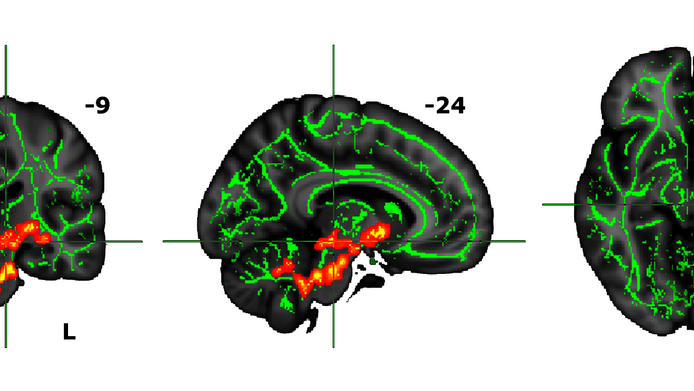How our gender influences us

In basic research, breakthroughs are often the result of a combination of curiosity and chance. In order to explore biological factors in mental illnesses such as depression or anxiety disorders, a team of researchers at the Medical University of Vienna (MedUni Wien) investigated the impact of sex hormones on the brain. Working in close cooperation with the Department of Obstetrics and Gynaecology, the Department of Biomedical Imaging and Image-guided Therapy and the Center for Medical Physics and Biomedical Engineering, the scholars from the Department of Psychiatry and Psychotherapy were rewarded with a significant new insight. They demonstrated that gender identity is reflected in the brain, including the brains of transgender individuals, formerly also known as transsexuals.
The gender perspective
This project was conducted within the context of a project supported by the Austrian Science Fund FWF. The study garnered such intense international attention in both expert circles and the media “that researchers from the US, themselves transgender individuals, came to see us here at the Vienna General Hospital”, according to principal investigator Rupert Lanzenberger. “In psychiatry, there are many illnesses that occur much more frequently in either women or in men, such as anxiety disorders and depression, or addiction and autism”, says Professor Lanzenberger, as he describes major objectives of the project. “We wanted to investigate the root causes of these illnesses from a gender perspective and were looking for a model that would allow us to elucidate influences of sex-hormones on the human brain.” Over five years, an interdisciplinary team led by Lanzenberger examined transgender individuals who were seeking medical help and looking to hormonal therapy as a way of getting closer to the opposite gender.
Hormonal effects on the brain
Using magnetic resonance tomography (MRT), the researchers examined both transsexual subjects and control subjects to observe what happens in the brain when opposite-sex hormones are administered over a prolonged period in order to achieve opposite-sex hormonal blood levels. “We were able to demonstrate the effect of hormones on language processing, on functions such as risk-taking behaviour, spatial cognition and impulsiveness, as well as on structural brain connections between female and male subjects”, Lanzenberger explains. It was interesting that the scans also showed that, prior to hormonal treatment, the brain structure of transgender individuals exhibited levels falling in the mid-range between the two sexes.

Testosterone as a key factor
In concrete terms, the research teams from MedUni Wien were able to show that an increase of blood testosterone levels induced a decrease in the volume of two brain regions of central importance for language processing, and it also changed their connections. “This suggests that the impact of testosterone on language processing occurs via the influence it has on the structure of grey and white matter in the corresponding brain region”, notes Lanzenberger and goes on to say: “We assume that some of the difference in white matter we found may emerge very early on, perhaps in the womb or before puberty. That would make it a type of biological information, a marker for gender identity.” The knowledge that brain connections and their functions can change as a result of hormone administration even in adulthood may be important in certain situations, for instance when the neuroplasticity of the brain is reduced, as is presumably the case in depression. Using another imaging procedure, positron emission tomography (PET), the researchers therefore explored the impact of hormones on the neurotransmitter serotonin, which is known to improve an individual's mood. The result showed that testosterone significantly increased serotonin transporter density.
Further investigations
In a number of further analyses, not all of which are completed and/or published at this time, the project team at MedUni Wien has recorded a great volume of data, for instance involving pain sensitivity, the sense of smell, changes in behaviour or in the quality of life of the subjects in order to correlate them with the results of the brain scans and, ultimately, gain a better understanding of gender differences. “We also look into genetics, because we assume that hundreds of genes are turned on and off by hormones”, explains Lanzenberger. This would, for example, enable the researchers to study their influence on blood vessels.
Gender and precision medicine
Sex hormones have a significant impact on the (adult) brain, as the Vienna research team was able to demonstrate. Hence, gender identity is not only a psychological phenomenon, but it can be determined biologically. “We now know that there are biological differences, and that these differences may change over a person’s lifespan”, notes Lanzenberger. For clinical research this means that we may get better insights into which hormonal dysfunctions may be linked to anxiety disorders and why women suffer from such disorders two to three times more often than men. The more knowledge we have about gender differences, the better medical science will be able to target therapeutic measures precisely and the better the advances in so-called personalised medicine will be.
Personal details
Rupert Lanzenberger heads the Neuroimaging Lab (NIL) at the Department of Psychiatry and Psychotherapy at the Medical University of Vienna. His main research focus lies on multimodal clinical imaging of the brain by means of positron emission tomography (PET) and functional magnetic resonance imaging (fMRI).
Publications
http://www.ncbi.nlm.nih.gov/pubmed/?term=lanzenbergerr+kranz+%28transgender+or+transsexuals%29





